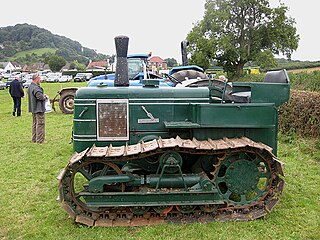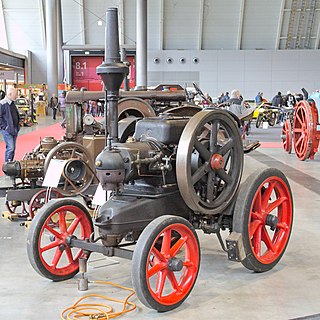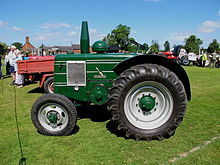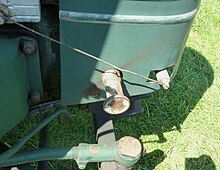
Coventry Climax was a British forklift truck, fire pump, racing, and other speciality engine manufacturer.

In 1933, the Great Western Railway introduced the first of what was to become a successful series of diesel railcars, which survived in regular use into the 1960s, when they were replaced with the new British Rail "first generation" type diesel multiple units.

Trojan was a British automobile manufacturer producing light cars between 1914 and 1965, and light commercial vehicles for a short time.

Marshall, Sons & Co. was a British agricultural machinery manufacturer founded in 1848. The company was based in the Britannia Iron Works, Gainsborough, Lincolnshire. Early production was of steam engines and agricultural machinery. Later production included diesel tractors such as the Field Marshall, Track Marshall and former Leyland wheeled tractors.

The Swift Motor Company made Swift Cars in Coventry, England from 1900 until 1931. It grew progressively from James Starley's Coventry Sewing Machine Company, via bicycle and motorised cycle manufacture. The cars ranged from a single-cylinder car in 1900 using an MMC engine, through a Swift-engined twin-cylinder 7-horsepower light car in 1904, and a 3-litre model in 1913. After the First World War a successful range was sold during the 1920s, but the Cadet of 1930 was its last vehicle as it could not compete economically with volume manufacturers such as Ford and Morris Motors.
Henry Meadows, usually known simply as Meadows, of Wolverhampton, England were major suppliers of engines and transmissions to the smaller companies in the British motor industry. Founded in 1920 in Park Lane, Wolverhampton, as a car gearbox maker, they expanded into petrol engines in 1922 and in the 1930s built a large factory in Fallings Park, Wolverhampton.

The Detroit Diesel Series 92 is a two-stroke cycle, V-block diesel engine, produced with versions ranging from six to 16 cylinders. Among these, the most popular were the 6V92 and 8V92, which were V6 and V8 configurations of the same engine respectively. The series was introduced in 1974 as a rebored version of its then-popular sister series, the Series 71. Both the Series 71 and Series 92 engines were popularly used in on-highway vehicle applications.

The hot-bulb engine is a type of internal combustion engine in which fuel ignites by coming in contact with a red-hot metal surface inside a bulb, followed by the introduction of air (oxygen) compressed into the hot-bulb chamber by the rising piston. There is some ignition when the fuel is introduced, but it quickly uses up the available oxygen in the bulb. Vigorous ignition takes place only when sufficient oxygen is supplied to the hot-bulb chamber on the compression stroke of the engine.

The Detroit Diesel Series 71 is a two-stroke diesel engine series, available in both inline and V configurations, manufactured by Detroit Diesel. The number 71 refers to the nominal displacement per cylinder in cubic inches, a rounding off of 70.93 cu in (1.2 L).
The Detroit Diesel 149 is a series of two-stroke diesel engines manufactured by Detroit Diesel which were first announced in early 1966. After Detroit Diesel was spun off in 1988 and later acquired by MTU, production of Series 149 engines was discontinued around 2000.

The Land Rover Series I, II, and III, or simply the Land-Rover are compact British off-road vehicles, produced by the Rover Company since 1948, and later by British Leyland. Though inspired by the World War II jeep, the Land Rover immediately distinguished itself from all other cars. From launch, it was the first mass-produced civilian four-wheel drive car with doors, and an available hard roof. Contrary to conventional car and truck chassis, it used a sturdier fully box-welded frame. Furthermore, due to post-war steel shortage, and aluminium surplus, Land Rovers received non-rusting aluminium alloy bodies, favouring their longevity. In 1992, Land Rover claimed that 70% of all the vehicles they had built were still in use.

The Lanz Bulldog was a series of tractors manufactured by Heinrich Lanz AG in Mannheim, Baden-Württemberg, Germany. Production started in 1921 with the Lanz HL, and various versions of the Bulldog were produced up to 1960, one of them being the Lanz Bulldog D 9506. John Deere purchased Lanz in 1956 and started using the name "John Deere Lanz" for the Lanz product line. A few years after the Bulldog was discontinued the Lanz name fell into disuse. The Lanz Bulldog was one of the most popular German tractors, with over 220,000 of them produced in its long production life. The name "Bulldog" is widely used in Germany as a synonym for tractors even today, especially in Bavaria.

Track Marshall was a crawler tractor, that had its origins in the merger of the Fowler and Marshall companies shortly after WW2.

Mahindra Major was a renamed update of the Jeep CJ3B, developed by Mahindra & Mahindra. It was first marketed in 2004. It has the altered "New Generation Chassis," which was a 115 x 60 mm steel box section rather than the 100 x 50 mm C-section used earlier. This chassis was first seen on the Armada beginning in January 1998 and gradually filtered into the rest of Mahindra's range. Over the years, the Mahindra Major has become a popular vehicle in rural areas of India, where it is used for transportation, agriculture, and other tasks. Due to its resemblance to the original Jeep, it has become commonly known as a "jeep" in these areas, even though it is a different vehicle made by a different company.
The Rolls-RoyceC range was a series of in-line 4, 6 and 8 cylinder diesel engines used in small railway locomotives, construction vehicles, marine and similar applications. They were manufactured by the Rolls-Royce Oil Engine Division headed by William Arthur Robotham to 1963, initially at Derby and later at Shrewsbury, from the 1950s through to 1970s.
Prior to and during World War II the United States Army called several tractors M1 Light Tractor. Under the Ordnance Corps these commercial off-the-shelf tractors were meant to tow artillery pieces so were not equipped with blades like their Engineer counterparts. Eventually these were replaced by purpose built "High Speed Tractors" (HST). Some tractors were equipped with crane attachments for ammunition, and material handling.

The Porsche-Diesel Standard 218, also known as N 218, is the third generation of the two-cylinder Standard tractor series, manufactured by Porsche-Diesel Motorenbau GmbH in Friedrichshafen am Bodensee. The Standard 218 was produced in four different variations. It succeeded its predecessor, the Porsche-Diesel 208 in 1957. In total, the Porsche plant produced more than 12,000 Standard 218 tractors from 1957 to 1963.
Stuart Turner Ltd is a British engineering company, based in Henley-on-Thames, Oxfordshire, England, founded by engineer Sidney Marmaduke Stuart Turner in 1906.

The Lanz HL, also known as Lanz Bulldog HL and Lanz Bulldog HL 12, is an agricultural machine and tractor made by Heinrich Lanz & Co. OHG. It was developed by German engineer Fritz Huber and is the first Lanz tractor to feature the "Bulldog" Akroyd engine. Thus, it is the first series production Lanz Bulldog. The Lanz HL was introduced at the 1921 DLG agriculture fair in Leipzig and stayed in production until 1927. In total, more than 6,000 units were made. The HL Bulldog engine was also sold as a stationary engine; this article primarily describes the HL agricultural tractor.


















